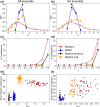Moving the epidemic tipping point through topologically targeted social distancing
- PMID: 34221247
- PMCID: PMC8237042
- DOI: 10.1140/epjs/s11734-021-00138-5
Moving the epidemic tipping point through topologically targeted social distancing
Abstract
The epidemic threshold of a social system is the ratio of infection and recovery rate above which a disease spreading in it becomes an epidemic. In the absence of pharmaceutical interventions (i.e. vaccines), the only way to control a given disease is to move this threshold by non-pharmaceutical interventions like social distancing, past the epidemic threshold corresponding to the disease, thereby tipping the system from epidemic into a non-epidemic regime. Modeling the disease as a spreading process on a social graph, social distancing can be modeled by removing some of the graphs links. It has been conjectured that the largest eigenvalue of the adjacency matrix of the resulting graph corresponds to the systems epidemic threshold. Here we use a Markov chain Monte Carlo (MCMC) method to study those link removals that do well at reducing the largest eigenvalue of the adjacency matrix. The MCMC method generates samples from the relative canonical network ensemble with a defined expectation value of . We call this the "well-controlling network ensemble" (WCNE) and compare its structure to randomly thinned networks with the same link density. We observe that networks in the WCNE tend to be more homogeneous in the degree distribution and use this insight to define two ad-hoc removal strategies, which also substantially reduce the largest eigenvalue. A targeted removal of 80% of links can be as effective as a random removal of 90%, leaving individuals with twice as many contacts. Finally, by simulating epidemic spreading via either an SIS or an SIR model on network ensembles created with different link removal strategies (random, WCNE, or degree-homogenizing), we show that tipping from an epidemic to a non-epidemic state happens at a larger critical ratio between infection rate and recovery rate for WCNE and degree-homogenized networks than for those obtained by random removals.
© The Author(s) 2021.
Figures






References
-
- M. Greenstone, V. Nigam, Does social distancing matter? University of Chicago, Becker Friedman Institute for Economics Working Paper, (2020–26) 2020
-
- M. Farboodi, G. Jarosch, R. Shimer, Internal and external effects of social distancing in a pandemic, No. w27059. National Bureau of Economic Research (2020)
LinkOut - more resources
Full Text Sources
Miscellaneous
